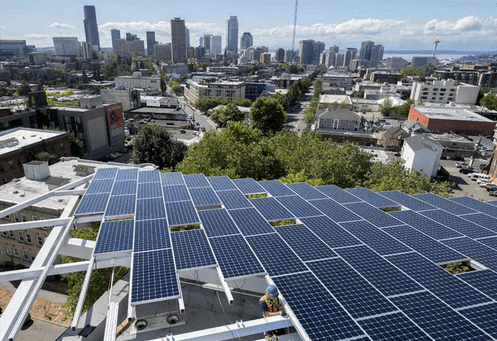Bullitt Foundation opens new building in Seattle that redefines environmentally-friendly
The roof of the Bullitt Center will be covered with solar panels. (Photo by John Stamets.)
Earth Day, Monday, was the official opening of what Denis Hayes, the man behind Earth Day, calls the greenest building in the world.
It’s a six-story office structure built to house the Bullitt Foundation — which Hayes heads — and other tenants they hope to attract.
“This is a building that functions like an organism — so say it has ears, it has eyes, it doesn’t have a sense of smell, but it has pores that open and close automatically depending upon outside conditions,” Hayes said.
It even has composting toilets, the only six-story building in the world that can say that. Every six months, or so, the giant composting containers in the basement will be emptied, with all of the compost used as fertilizer.
“A flush is about one cup,” he said. A traditional toilet might use nearly two gallons per flush.
The building won’t use any artificial irrigation, either. And, the building will collect rainwater and use it for various purposes inside the building. There’s a 56,000 gallon cistern in the basement where the water is collected. It’ll be filtered, chlorinated and filtered again before being sent out of faucets and drinking fountains throughout the building.
Hayes compares the elaborate system to the way the ecosystem of the site worked, when it was home to a forest.
“Just like that Douglas Fir forest, the water that falls on the site remains on the site,” he said.
But in addition to building the structure in as environmentally-friendly a way as possible, they’re also imposing conditions on future tenants, to keep their energy use low.
“We’ve got these little kilowatt meters that you measure everything that you’re currently using, and it tells you how much of a draw your computers are and your task lights are and your printer is and what have you,” Hayes said. “And you just calculate a way to stay within that budget.”
The building goes out of its way to take advantage of natural light. One wall has 20-foot tall windows. But it tries to do it in an efficient way. In fact, the building has shutters that open and close automatically, based on the position of the sun and the atmosphere inside the building.
There’s a weather station nearby that feeds data into the building, so it can adjust a number of different settings, to optimize energy efficiency.
“If you want to change radically the way things are built, there are a number of decision makers that you need to get engaged,” he said. “They certainly include architects, but they tend to be wildly enthusiastic about this sort of thing anyway. Developers, a little bit less so. Bankers, deeply skeptical. Appraisers, completely bewildered.”
Some two dozen things in this building, Hayes said, would have been illegal under Seattle’s standard buidling codes. But by showing that the building, by being truly innovative, would perform better than the code would have produced, Bullitt received an exemption.
“And we’d love to get that replicated in thousands of cities across the country,” he added.
Hayes insists that nothing about the building is untested — in other words, he’s not worried that something’s so new they won’t truly know how it performs — or how well it lasts. But that’s not to say there won’t be little bumps along the way.
“There are things that are going to malfunction in the first month. We’ve got a first-rate team of building managers who will get them fixed,” he said. “It will be shaking down but none of these are going to be permanent failures. Everything here exists someplace else.”
And on top of all the ways that the Bullitt building will conserve power, it’s also setting out to generate enough energy, and minimize its own usage, so that it will be self-sufficient — even in rainy Seattle, where sunshine can be at a premium certain times of the year.
“We’re showing you can generate enough energy on an annual basis to meet the needs of a six-story building in Seattle. And I think that means you’ve got to be super-efficient in your use of energy. But I think it will be a real revelation to people,” he said.
The foundation plans to charge market rates for its leases — and it spent about 25 percent more than it would have to build it under conventional standards, so this isn’t going to be a highly profitable venture. But Hayes says the building will be cash-flow positive in the first year.
And with its composting toilets and other energy-saving features, it’s not going to be attractive to every employer. But Hayes is confident it will serve a need.
“It’s sort of self-selecting a bunch of people who do want to ride their bikes to work, and they tend to be the kinds of young people that software firms and communications firms and some engineering firms are trying to attract that are locating here,” he said.
But over time, Hayes said, he’s convinced the building will be a popular one. And it better be.
He convinced the foundation’s board to invest one-third of its endowment in getting it constructed and operating.
